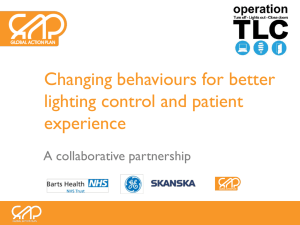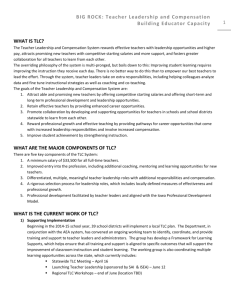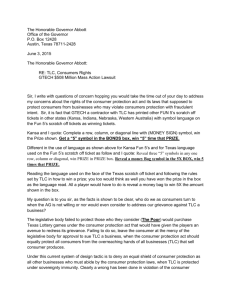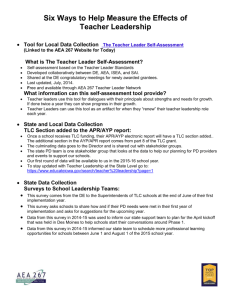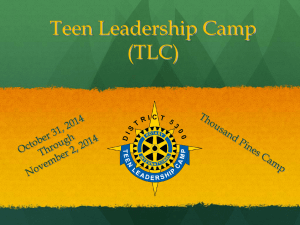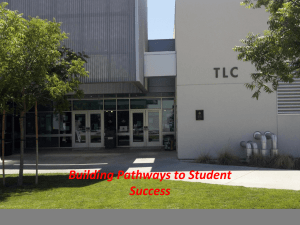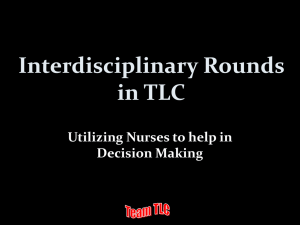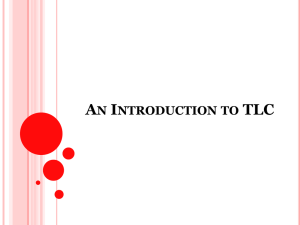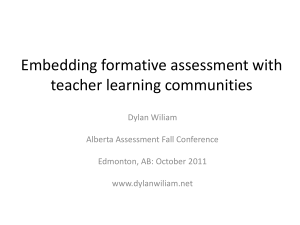Domain 2 - Classroom Environment
advertisement
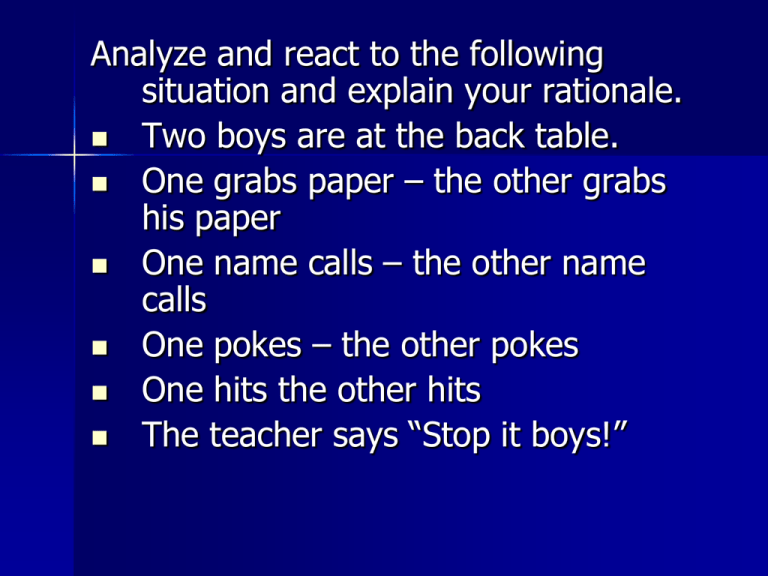
Analyze and react to the following situation and explain your rationale. Two boys are at the back table. One grabs paper – the other grabs his paper One name calls – the other name calls One pokes – the other pokes One hits the other hits The teacher says “Stop it boys!” Domain 2 The Classroom Environment Wall Public Schools New Teacher Orientation August 2013 Children now love luxury. They have bad manners, contempt for authority. They show disrespect for their elders and they love chatter in the place of exercise. Children are now tyrants, not the servants of their households. They no longer rise when elders enter the room. They contradict their parents, chatter before company, gobble up dainties at the table, cross their legs and tyrannize over their teachers. Socrates 60 50 Least Eff School/Most Eff Teacher 80 Most Eff. School/Most Eff. Teacher Most Eff. School/Least Eff. Teacher 20 Least Eff School/Least Eff Teacher 40 Avg. School/Avg. Teacher Effects of School vs. Teacher Student Entering at 50th Percentile Percentile Rank After 2 Years 120 100 96 63 37 3 0 The single most important factor affecting student achievement: THE TEACHER Functions of An Effective Teacher Utilizing classroom curriculum to facilitate student learning Making choices about instructional strategies Using effective classroom management techniques Objective The learner will use the components of Domain 2 in Charlotte Danielson’s Framework for Teaching to apply instructional techniques that will promote a positive, efficient learning environment and foster a culture of productivity in the classroom. The Components of Domain 2 1. Creating an Environment of Respect and Rapport RELATIONSHIPS 2. Establish a Culture for Learning RIGOR AND RELEVANCE 3. Managing Classroom Procedures ROUTINES 4. Managing Student Behavior RULES AND RESPECT 5. Organizing Physical Space Agenda Brief History Rules & Procedures Disciplinary Interventions Teacher/student relations Getting off to a good start Teach Like a Champion Techniques Born or Made? Good classroom managers are teachers who understand and use specific techniques Awareness of and training in these techniques can change teacher behavior, which in turn changes student behavior and ultimately affects student achievement positively Research evidence supports this assertion Real History History First not till 1970 – Brophy 1996 Effective classroom managers tended to employ different types of strategies with different types of students Ineffective classroom managers tended to use the same strategies regardless of the type of student or the situation All recognized classroom management as a critical aspect of effective teaching Identified critical dimensions of Classroom management Critical Dimensions “Withitness” – awareness of potentially disruptive behavior and immediate attention to it – separates effective from average Smoothness & momentum during presentations Informing students of expectations both behavioral and procedural at specific times Variety and challenge of student work Analyze and react to the following situation, order your actions and explain your rationale. Two students are at your table receiving help. A child in the class has started to cry. The students at a learning center have become disengaged and you feel they may soon become disruptive. An angry parent has shown up demanding to see you immediately. “The ineffective teacher begins the first day of school attempting to teach a subject or do a fun activity and spends the rest of the year running after the students.” - Harry K. Wong Rules & Procedures Research supports notion that designing & implementing rules and procedures in class has a profound impact on student behavior and learning Should be explanation and group input Viewed as a contract between teacher & students Not more than 5 to 8 at the elementary level Rules vs. Procedures Rules - general Respect others and their property General expectation for behavior Procedures - specific Managing materials Transitions Group / individual work Begin / end of day Beginning/Ending - Day/Class * Sets the tone for what follows Threshold - TLC Beginning well especially important in selfcontained class Begin with specific social activities Administrative activities Meaningful tasks that can be completed independently Procedures for putting away materials Tight Transitions -TLC If you were able to cut a minute apiece from ten transitions a day and sustained that improvement for one hundred eighty school days, you would create approximately thirty hours of instructional time over the school year. That is like gaining an additional week of school! Tight Transitions - TLC & Interruptions * Leaving & returning to the room Use of the bathroom Use of library and computer lab Hall walking Cafeteria & playground Fire & emergency drills Classroom helpers The principal is constantly reminding your class of proper hallway behavior. How can you get your class to “walk that way”? Use of Materials & Equipment Distributing materials Collecting materials Storage of common materials Teacher’s desk & storage areas Students’ desks Pencil Sharpening Group Work Movement in & out of the group Expected behaviors of students in group Expected behaviors of students not in group Group - with teacher Seatwork & Teacher Led Activities * Student attention during presentations Student participation Talking among students Obtaining help Out of seat behavior Behavior with work has been completed Time on task *** Involve Students * Connect to prior knowledge – discuss Present those rules that YOU have identified Students invited to suggest alternatives, additions, and deletions Discussion – compromise Teacher has final word Scattergories Brainstorm with your group things you hide that begin with H Goal Be aware of & employ specific techniques that acknowledge and reinforce acceptable behavior and acknowledge and provide negative consequences for unacceptable behavior Interventions Research shows that interventions that do not include any type of reaction – positive or negative – to student behavior, have the lowest effect size. Human beings do best in an environment of feedback (specificity) Research supports premise that a balance of both positives and negative consequences is most effective When you remind Johnny of a classroom rule he always argues. This is frustrating your ability to manage the class. What do you do? Teacher Reaction Verbal & physical teacher reactions reinforce acceptable behavior and acknowledge or provide negative consequences for unacceptable – Examples: eye contact, proximity, physical signals, verbal reminders (privately, subtly), state desired behavior, be specific, direct to stop Teacher Reaction Stimulus Cueing – Cue before inappropriate behavior begins Precise Praise - TLC Catch a student being good 10 pennies Tangible Recognition * Concrete symbol of appropriate behavior Token economies Thorough discussion of the rationale Research shows most effective if awarded for positive behaviors and taken away for negative behaviors Ensure it is not perceived as a bribe or coercion Group Contingency Recognition for positive behavior Systems of rewards for a group or the entire class Home Contingency * Make parents aware of positive and negative behaviors – Short note – phone call - email – preprinted form - comments Collaboration in establishing parameters and in rewards or consequences Parent conference A student is continually calling out in class. Come up with some strategies to change this behavior. Scattergories Brainstorm with your group activities that begin with S Teacher-Student Relationships If teacher has a good relationship then students more readily accept the rules and procedures and the disciplinary actions that follow their violations Warm/Strict – TLC Props – TLC J-Factor – TLC Techniques to Establish Appropriate Level of Dominance Exhibiting Assertive Behavior Assertive body language – eye contact, facial expression Strong voice – avoid emotion Persisting until the appropriate behavior is displayed 1. Do it Again -TLC Techniques to Establish Appropriate Level of Dominance Establishing Clear Learning Goals * Establishing learning goals at the beginning of a unit of instruction Providing feedback on the goals Continually and systematically revisiting the goals Set clear expectations for performance and behavior -- rubrics Techniques to Establish Appropriate Level of Cooperation Take a personal interest in students – Concern for needs and opinions – Talking informally w/ children – Singling out and talking to a few students in the lunchroom – Complimenting on achievements in and out of school – Greeting students by name as they arrive - Threshold - TLC Techniques to Establish Appropriate Level of Cooperation Use equitable and positive classroom behaviors – Eye contact w/each student (scanning) – Circulate –TLC -to all areas of the room – Make sure to call on all students – not just those that always have hand up – Cold Call - TLC – Provide appropriate wait time – Think-Pair-Share Techniques to Establish Appropriate Level of Cooperation Responding appropriately to students’ incorrect responses – – – – – – – Emphasize what was right Encourage collaboration Restate the question Rephrase the question Give hints or clues Provide answer – ask for elaboration Respect student's option to pass – No Opt Out - TLC Emotional Objectivity Look for reasons why student misbehaves (reframing) – Road rage example Monitor own attitudes about students – positive expectations Take care of yourself STEP Summary Specific Behaviors of Effective Classroom Managers Holding and communicating high expectations for student learning and behavior. Establishing and clearly teaching classroom rules and procedures. Specifying consequences. Enforcing classroom rules promptly, consistently and equitably. Specific Behaviors of Effective Classroom Managers Sharing with students the responsibility for classroom management. Monitoring classroom activities. Creating opportunities for students to experience success. Planning creative, challenging learning activities. Using humor. Prevention Strategies Focus Direct instruction Monitor/circulate Model appropriate behavior Establish rules and consequences Name drop Welcome students Call home with good news Transpose critical comments Point out talents/predict success Make appointments Strategies for Common Disruptive Behaviors Use the friendly “evil eye” Invade space Whisper Smile and request Allow thinking time Change locations State your want Give information Give choices Respect the struggle Answer questions with questions Inform parents Inform counselor Creating an Environment of Respect and Rapport Teacher interaction with students Check-in with your students as they enter the classroom. Learn and use all of your students’ names. Make an effort to speak to every student every day. Make a connection, build a rapport, remember your role. Sarcasm is not an effective form of communication. Be polite! Expect your students to be polite. Student interaction with students Encourage positive kind interactions among students. Expect your students to be polite to one another. Eye-rolling, snickering and sarcasm among students should not be tolerated. Establishing a Culture for Learning Importance of Content Show enthusiasm for what you are teaching. Highlight the relevance of the content. Help students to make connections to why they are learning the content. Expectations for Learning and Behavior Ensure that your students know that although academic expectations are high, they are capable of reaching them. Send the message that while the work in the classroom is challenging students are able to achieve if they work hard. Student Pride in Work Effort and persistence is expected and recognized. All students are expected to participate in all activities. Managing Classroom Procedures Management of Instructional Groups Teach students how to work independently in groups with little supervision from the teacher. Provide students with procedures that are specific, concrete, sequential, and observable when working in groups. Management of Transitions Ensure that students “know the drill” to minimize loss of instructional time due to transitions. Provide students with procedures that allow students to move from one activity to another seamlessly. Managing Classroom Procedures (cont.) Management of Supplies Have all necessary supplies on hand for every activity, every time. Establish clear routines for distribution and collection of materials. Performance of Non-Instructional Duties Become a master of multi-tasking. Non-instructional duties should never take away from instructional time. Empower students to take a role in these duties with minimal supervision. Managing Student Behavior Expectations Establish clear expectations for behavior. Consistently reinforce with established consequences. Keep rules to minimum. Monitoring Behavior Circulate. Use proximity. Be aware. Be preventative. Be consistent. Response to Misbehavior Positive Framing to address and correct misbehavior Emotional Constancy – QTIP – Earn their trust by remaining in contro Avoid acrimony between teacher and student. You Can Do It! Use the valuable experience of your staff members. Share your stories – it will make you feel better and might get you some good advice. Ask your principal for help. Get your self a book with ideas - TLC Keep track of what works – and what doesn’t. If at first you succeed, try – try – and try some more! Exit Ticket Describe one technique you learned and will use in your classroom this year. Tell about something you learned today that made you reflect upon your own teaching and habits.

